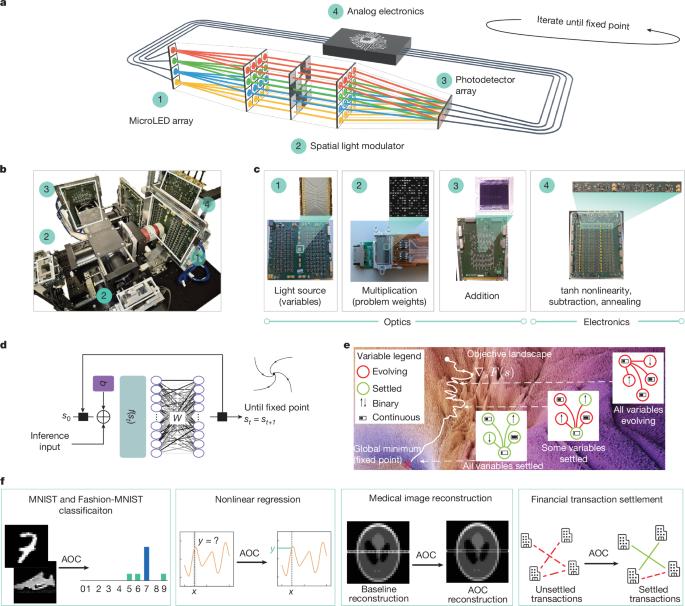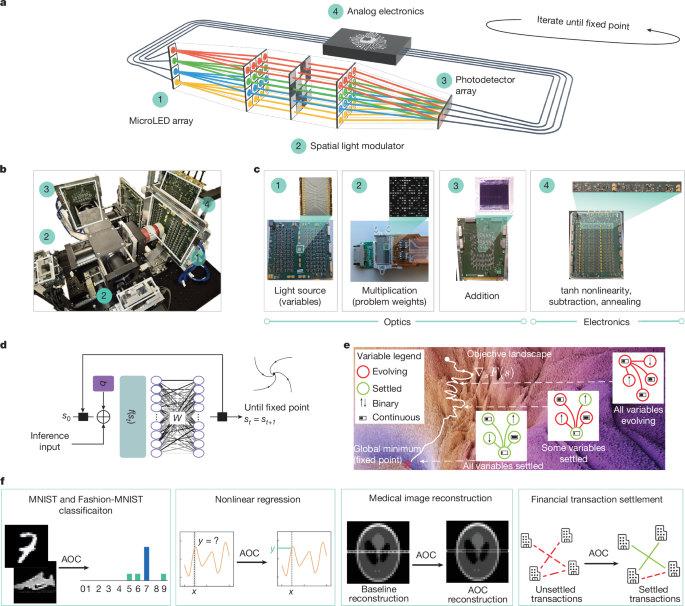用于人工智能推理和组合优化的模拟光学计算机
IF 48.5
1区 综合性期刊
Q1 MULTIDISCIPLINARY SCIENCES
引用次数: 0
摘要
人工智能(AI)和组合优化推动了科学和工业领域的应用,但它们不断增长的能源需求挑战了数字计算的可持续性。大多数非常规计算系统1,2,3,4,5,6,7的目标要么是人工智能,要么是优化工作负载,并且依赖于频繁的、能源密集型的数字转换,从而限制了效率。这些系统还面临着应用硬件不匹配的问题,无论是处理内存瓶颈的神经模型,映射现实世界的优化问题,还是与固有的模拟噪声作斗争。本文介绍了一种模拟光学计算机(AOC),它结合了模拟电子学和三维光学,可以在单个平台上加速人工智能推理和组合优化。这种双域能力是通过快速的定点搜索实现的,避免了数字转换并增强了噪声鲁棒性。通过这种不动点抽象,AOC实现了具有递归推理潜力的新兴计算绑定神经模型,并实现了一种先进的梯度下降方法用于表达优化。我们通过四个案例研究:图像分类、非线性回归、医学图像重建和金融交易结算,展示了共同设计硬件和抽象的好处,以响应数字加速器和深度学习模型的共同进化。AOC采用可扩展的消费级技术,为更快和可持续的计算铺平了一条充满希望的道路。它对迭代、计算密集型模型的原生支持为促进人工智能和优化的未来创新提供了可扩展的模拟平台。本文章由计算机程序翻译,如有差异,请以英文原文为准。


Analog optical computer for AI inference and combinatorial optimization
Artificial intelligence (AI) and combinatorial optimization drive applications across science and industry, but their increasing energy demands challenge the sustainability of digital computing. Most unconventional computing systems1–7 target either AI or optimization workloads and rely on frequent, energy-intensive digital conversions, limiting efficiency. These systems also face application-hardware mismatches, whether handling memory-bottlenecked neural models, mapping real-world optimization problems or contending with inherent analog noise. Here we introduce an analog optical computer (AOC) that combines analog electronics and three-dimensional optics to accelerate AI inference and combinatorial optimization in a single platform. This dual-domain capability is enabled by a rapid fixed-point search, which avoids digital conversions and enhances noise robustness. With this fixed-point abstraction, the AOC implements emerging compute-bound neural models with recursive reasoning potential and realizes an advanced gradient-descent approach for expressive optimization. We demonstrate the benefits of co-designing the hardware and abstraction, echoing the co-evolution of digital accelerators and deep learning models, through four case studies: image classification, nonlinear regression, medical image reconstruction and financial transaction settlement. Built with scalable, consumer-grade technologies, the AOC paves a promising path for faster and sustainable computing. Its native support for iterative, compute-intensive models offers a scalable analog platform for fostering future innovation in AI and optimization. An analog optical computer that combines analog electronics, three-dimensional optics, and an iterative architecture accelerates artificial intelligence inference and combinatorial optimization in a single platform, paving a promising path for faster and sustainable computing.
求助全文
通过发布文献求助,成功后即可免费获取论文全文。
去求助
来源期刊

Nature
综合性期刊-综合性期刊
CiteScore
90.00
自引率
1.20%
发文量
3652
审稿时长
3 months
期刊介绍:
Nature is a prestigious international journal that publishes peer-reviewed research in various scientific and technological fields. The selection of articles is based on criteria such as originality, importance, interdisciplinary relevance, timeliness, accessibility, elegance, and surprising conclusions. In addition to showcasing significant scientific advances, Nature delivers rapid, authoritative, insightful news, and interpretation of current and upcoming trends impacting science, scientists, and the broader public. The journal serves a dual purpose: firstly, to promptly share noteworthy scientific advances and foster discussions among scientists, and secondly, to ensure the swift dissemination of scientific results globally, emphasizing their significance for knowledge, culture, and daily life.
 求助内容:
求助内容: 应助结果提醒方式:
应助结果提醒方式:


